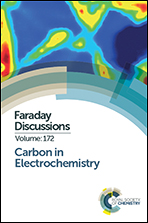Laser heated boron doped diamond electrodes: effect of temperature on outer sphere electron transfer processes
Abstract
Thermoelectrochemical experiments can reveal significant information about electrochemical processes compared to ambient only measurements. Typical thermoelectrochemistry is performed using resistively heated wires or laser heated electrodes, both of which can suffer drawbacks associated with the electrode material employed. Boron doped diamond (BDD) is ideal for thermoelectrochemical investigations due to its extremely high thermal conductivity and diffusivity, extreme resistance to thermal ablation (can withstand laser power densities, Pd, of GW cm−2 for nanosecond pulses) and excellent electrochemical properties (low background currents and wide potential window). In this paper we describe the use of a pulsed laser technique to heat the rear of a 1 mm diameter conducting BDD disc electrode, which drives electrochemical solution reactions at the front face. Maximum electrode temperatures of 90.0 °C were recorded experimentally and confirmed by finite element modelling (FEM). The effect of laser pulsed heating (maximum 3.8 kW cm−2; 10 ms on and 90 ms off) on the cyclic voltammetric response of two fast (reversible) outer sphere electron transfer redox mediators (Ru(NH3)63+/2+ and IrCl62−/3−) are investigated. In particular, we observe pulsed increases in the current, which increase with increasing Pd. The potential of the peak current is shifted positively for the Ru(NH3)63+/2+ couple (in accordance with a positive temperature coefficient, β, +0.68 mV K−1) and negatively for the IrCl63−/2− couple (β = −0.48 mV K−1). Scanning backwards, in contrast to that observed for a macrodisc electrode in ambient solution, a cathodic peak is again observed for Ru(NH3)63+/2+ and an anodic peak for IrCl63−/2− couple. We attribute this response to the entropy of the redox reaction and the time-dependant change in mass transport due to the induced thermal gradients at the electrode/electrolyte interface. The observed responses are in qualitative agreement with FEM simulations.
- This article is part of the themed collection: Carbon in Electrochemistry

 Please wait while we load your content...
Please wait while we load your content...